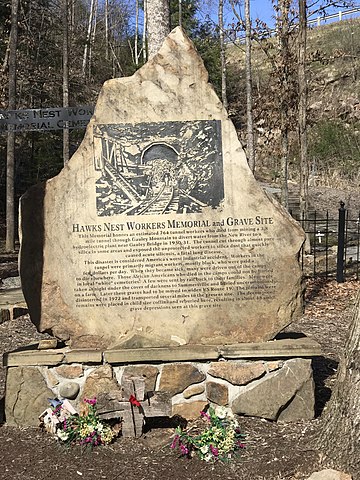The Hawks Nest Tunnel Disaster was a tragic industrial incident that occurred during the construction of the Hawks Nest Tunnel near Gauley Bridge, West Virginia, in the early 1930s. The project was part of a hydroelectric scheme, and the disaster had devastating consequences for the workers involved.
Key Details:
- Period: The project took place during the early 1930s, with construction starting in 1930.

- Nature of the Project:
- The construction of the Hawks Nest Tunnel was part of a water diversion project for a hydroelectric plant.
- Subcontractor and Workers:
- A subcontractor, Rinehart and Dennis Company, was hired to construct the tunnel. Workers, primarily African American laborers, were employed for the construction.
Horrors of the Disaster:
- Silica Dust Exposure:
- The tunneling involved cutting through a high-silica rock formation. Workers were exposed to large amounts of airborne silica dust, leading to severe health consequences.
- Lack of Protective Measures:
- Inadequate safety measures were in place to protect workers from the harmful effects of silica dust. Many workers did not have access to respirators or proper ventilation.
- Health Impact:
- Prolonged exposure to silica dust resulted in a lung disease known as silicosis. Silicosis is a debilitating and often fatal respiratory condition caused by inhaling fine silica particles.
- Rapid Onset of Disease:
- Due to the intense exposure and lack of protective measures, workers experienced an unusually rapid onset of silicosis. Many became ill within months of working on the project.
- Death Toll:
- The exact number of deaths is uncertain, but estimates range from hundreds to possibly over a thousand. Many workers succumbed to silicosis, and the mortality rate was exceptionally high.
- Exploitation of Workers:
- The workers, many of whom were African American, were often exploited and lacked proper representation. They were not informed about the health risks associated with their work, and safety precautions were neglected.
Aftermath and Legal Implications:
- Legal Battles:
- The disaster led to legal battles and compensation claims on behalf of the affected workers. However, legal processes were slow, and many workers did not live long enough to see the resolution of their cases.
- Legacy of Injustice:
- The Hawks Nest Tunnel Disaster is often cited as a glaring example of environmental racism and exploitation of vulnerable workers. The lack of proper safety measures and medical care compounded the tragedy.
- Regulatory Changes:
- The disaster prompted increased awareness of occupational health and safety issues, leading to changes in regulations and standards to protect workers from hazardous conditions.
- Historical Recognition:
- The Hawks Nest Tunnel Disaster is now recognized as a historical tragedy, and efforts have been made to memorialize the victims and raise awareness about the injustices they faced.
The Hawks Nest Tunnel Disaster stands as a stark reminder of the human cost of industrial negligence, exploitation, and environmental hazards. It has played a role in shaping labor laws, safety regulations, and discussions around social justice in the United States.











